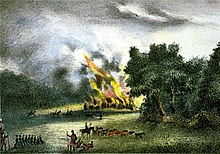
Back حرب السيمينول الثانية Arabic Segunda guerra semínola Spanish Seconde guerre séminole French Perang Seminole Kedua ID Guerra seminole (1835-1842) Italian Perang Seminole Kedua Malay Den andre seminolekrigen NB II wojna Seminolów Polish Вторая Семинольская война Russian Andra seminolekriget Swedish
This article's tone or style may not reflect the encyclopedic tone used on Wikipedia. (October 2022) |
| Second Seminole War | |||||||
|---|---|---|---|---|---|---|---|
| Part of the Seminole Wars and Indian removal | |||||||
 Rampage during the Second Seminole War. | |||||||
| |||||||
| Belligerents | |||||||
|
| Seminole | ||||||
| Commanders and leaders | |||||||
|
Andrew Jackson Martin Van Buren William Henry Harrison John Tyler Duncan Lamont Clinch Francis L. Dade (1835) † Winfield Scott (1836) David Moniac (1836) † Richard Keith Call (1836) Richard Gentry (1837) † Thomas S. Jesup (1836–38) Zachary Taylor (1838–40) Walker Keith Armistead (1840–41) William Jenkins Worth (1841–42) |
Osceola John Horse Holata Mico (Billy Bowlegs) Abiaca (Sam Jones) Micanopy Coacoochee (Wild Cat) Halleck Tustenuggee Halpatter Tustenuggee (Alligator) | ||||||
| Strength | |||||||
| more than 9,000 in 1837[5] cumulative 10,169 regulars, 30,000 militia and volunteers[6] | 900–1,400 warriors in 1835,[7] fewer than 100 in 1842[8] | ||||||
| Casualties and losses | |||||||
| 1,600 military, unknown civilian[9] | 3,000[10][11] | ||||||
The Second Seminole War, also known as the Florida War, was a conflict from 1835 to 1842 in Florida between the United States and groups of people collectively known as Seminoles, consisting of American Indians and Black Indians. It was part of a series of conflicts called the Seminole Wars. The Second Seminole War, often referred to as the Seminole War, is regarded as "the longest and most costly of the Indian conflicts of the United States".[12] After the Treaty of Payne's Landing in 1832 that called for the Seminole's removal from Florida, tensions rose until fierce hostilities occurred in the Dade battle in 1835. This conflict started the war. The Seminoles and the U.S. forces engaged in mostly small engagements for more than six years. By 1842, only a few hundred native peoples remained in Florida. Although no peace treaty was ever signed, the war was declared over on August 14, 1842.[13]
- ^ Rhodes, Rick (2003). Cruising Guide to Florida's Big Bend: Apalachicola, Chattahoochee, Flint, and Suwanee Rivers. Gretna, Louisiana: Pelican Publishing Company. pp. 20–21. ISBN 978-1-58980-072-4.
- ^ Schultz, Jack Maurice (1999). The Seminole Baptist Churches of Oklahoma: Maintaining a Traditional Community. Norman, Oklahoma: University of Oklahoma Press. p. 36. ISBN 978-0-8061-3117-7.
- ^ Swanton, John Reed (1922). Early History of the Creek Indians and Their Neighbors, Issue 73. Washington, D.C.: US Government Printing Office. p. 443.
- ^ Tucker, Spencer C. (2011). Encyclopedia of North American Indian Wars, 1607–1890. Vol. 1. Santa Barbara, California: ABC-CLIO. p. 719. ISBN 978-1-85109-697-8.
- ^ Missall 122–25
- ^ Mahon 323, 325
- ^ Buker 11
It is not clear whether this number includes Black Seminoles who often fought alongside the Seminoles. - ^ Mahon 318
- ^ Mahon 321, 325.
Missall 177, 204–205.
Florida Board of State Institutions. 9. - ^ Foner, Eric (2006). Give me liberty. Norton.
- ^ Mahon 321
- ^ Lancaster 18.
- ^ Bauer, P. (2021, December 21). Second Seminole War. Encyclopedia Britannica. https://www.britannica.com/event/Second-Seminole-War
© MMXXIII Rich X Search. We shall prevail. All rights reserved. Rich X Search